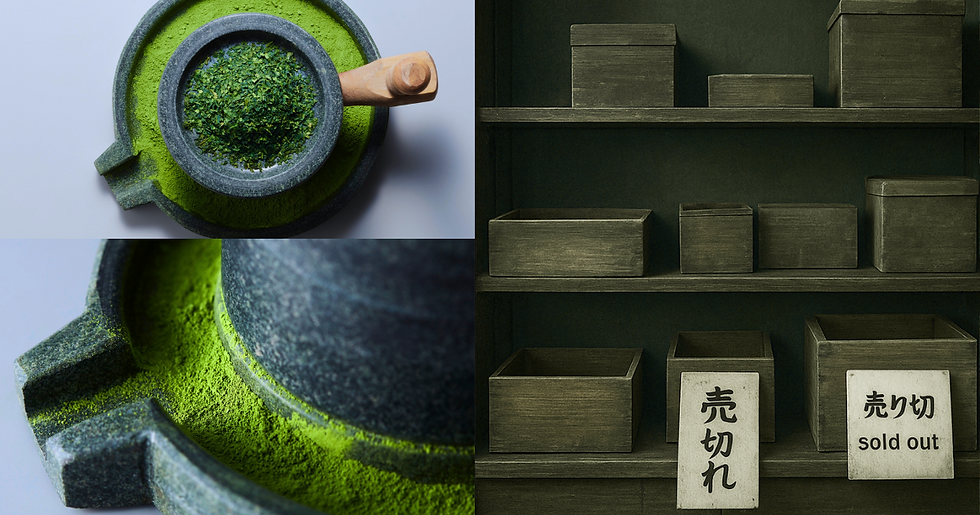How to Store Matcha in Bulk: The Complete Guide to Preserving Quality and Freshness
- taha611
- Oct 24
- 6 min read

Buying matcha in bulk is a smart move for cafes, restaurants, and matcha enthusiasts who want to save money while ensuring a steady supply. But here's the catch: matcha is notoriously delicate. Without proper storage, it can quickly lose its vibrant color, fresh taste, and valuable nutrients.
Whether you're stocking up for your business or personal use, understanding how to store matcha in bulk properly will save you money and ensure every cup tastes as fresh as the day it arrived.
Why Proper Matcha Storage Matters
Matcha is different from regular tea leaves. This finely ground powder has a much larger surface area exposed to air, making it incredibly vulnerable to degradation. When stored incorrectly, matcha can:
Lose its brilliant green color and turn yellowish-brown
Develop a stale, bitter, or fishy taste
Lose its nutritional benefits, including antioxidants
Clump together due to moisture exposure
Become completely unusable in as little as a few weeks
With the right storage techniques, bulk matcha can maintain its quality for months, giving you the best return on your investment.
The Three Enemies of Matcha: What You're Fighting Against
Before we dive into storage solutions, let's understand what threatens your matcha:
1. Oxygen (Oxidation)
When matcha is exposed to air, it begins to oxidation. This chemical reaction breaks down the chlorophyll that gives matcha its signature green color and degrades the catechins (antioxidants) that make it so healthy.
2. Light
UV rays and even artificial light can rapidly deteriorate matcha's quality. Light exposure accelerates oxidation and breaks down the delicate compounds that create matcha's umami flavor.
3. Heat and Humidity
Temperature fluctuations and moisture are matcha's worst enemies. Heat speeds up oxidation, while humidity causes clumping and can even lead to mold growth. Matcha absorbs odors easily, too, so storing it near strong-smelling foods is a recipe for disaster.

The Ultimate Guide to Storing Matcha in Bulk
Step 1: Choose the Right Containers
For bulk matcha storage, container selection is critical:
Best options:
Vacuum-sealed bags: These remove air completely, preventing oxidation. Look for multi-layer foil bags with zip locks.
Airtight tins or canisters: Food-grade stainless steel or aluminum containers with rubber gaskets provide excellent protection.
Opaque containers: Dark-colored or completely opaque containers block harmful light.
Avoid:
Clear glass jars (unless stored in complete darkness)
Plastic containers that aren't food-grade (can leach chemicals)
Containers without proper seals
Pro tip: When purchasing bulk matcha, it often arrives in large vacuum-sealed bags. Don't open the entire bag at once. Instead, transfer smaller portions to daily-use containers while keeping the bulk supply sealed.
Step 2: Implement a Portioning System
The less you expose your bulk matcha to air, the longer it stays fresh. Here's a smart portioning strategy:
Keep your main supply sealed: Store the bulk of your matcha in its original vacuum-sealed packaging in the freezer.
Create a working supply: Transfer a 1-2 week supply to a smaller airtight container for daily use.
Refrigerate your working supply: Keep this container in the refrigerator, bringing it to room temperature before opening to prevent condensation.
This system minimizes how often you expose your bulk supply to air and temperature changes.
Step 3: Control Temperature
Temperature control is non-negotiable for bulk matcha storage:
Unopened bulk matcha: Store in the freezer at 0°F (-18°C) or below. Properly sealed matcha can last 12+ months in the freezer.
Opened containers: Keep in the refrigerator at 35-40°F (2-4°C). Never freeze matcha once the seal is broken, as repeated temperature changes create condensation.

Important: Always let refrigerated or frozen matcha reach room temperature (about 30 minutes) before opening the container. Opening cold matcha creates condensation inside, which ruins the powder.
Step 4: Minimize Light Exposure
Store your matcha containers in:
A dark pantry or cupboard
Opaque containers
Wrapped in aluminum foil (if using clear containers)
Away from windows or direct lighting
Even if your matcha is in the fridge or freezer, light exposure during storage and retrieval adds up over time.
Step 5: Create a First-In, First-Out System
When buying matcha in bulk, you'll likely receive multiple batches. Implement a rotation system:
Label each container with the purchase or opening date
Always use older stock first
Track expiration dates (most matcha has a 12-month shelf life from production)
Keep an inventory log to prevent over-ordering
Special Considerations for Commercial Buyers
If you're purchasing bulk matcha for a cafe, restaurant, or retail business, consider these additional tips:
Daily Service Container
Keep a small tin (50-100g) at your service station that you refill daily. This prevents repeatedly opening your larger supply.
Training Staff
Ensure all employees understand proper matcha handling:
Always seal containers immediately after use
Never use wet utensils
Allow refrigerated matcha to reach room temperature first
Keep the work area clean and odor-free
Quality Checks
Perform regular quality assessments:
Visual inspection: Should be vibrant green, not brown or yellow
Smell test: Fresh matcha has a sweet, grassy aroma
Taste test: Should be smooth and umami-rich, not bitter
If quality has degraded, don't serve it to customers. Contact your supplier about your storage methods.

How Long Does Bulk Matcha Last?
With proper storage, here's what you can expect:
Unopened, frozen: 12-18 months
Opened, refrigerated: 2-3 months for optimal quality
Room temperature, opened: 1-2 weeks before noticeable degradation
Remember: These are quality timelines, not safety timelines. Matcha doesn't necessarily become unsafe to consume, but the taste and benefits diminish significantly.
Signs Your Bulk Matcha Has Gone Bad
Watch for these red flags:
Color change: Yellowing or browning instead of vibrant green
Odor: Musty, fishy, or no aroma at all
Texture: Excessive clumping that doesn't break apart
Taste: Bitter, flat, or cardboard-like flavor
Foam: Difficulty creating foam when whisked
If you notice any of these signs, it's time to either adjust your storage method or replace your supply.
Common Bulk Matcha Storage Mistakes to Avoid
Even experienced buyers make these errors:
Opening the entire bulk supply at once: This exposes all your matcha to air immediately.
Storing near the stove or coffee machine: Heat sources accelerate degradation.
Using the same scoop for different products: Cross-contamination affects flavor.
Forgetting to burp vacuum bags: When resealing, squeeze out excess air first.
Storing in the fridge door: Temperature fluctuates too much with frequent opening.
Sourcing Quality Bulk Matcha
Proper storage starts with quality sourcing. When buying matcha in bulk, quality matters just as much as price. Look for suppliers who:
Provide detailed information about the harvest date and origin
Use proper vacuum-sealed packaging
Offer different grades for different purposes (ceremonial vs. culinary)
Understand and can advise on storage requirements
Looking for a reliable bulk matcha supplier? Omakase Japan Wholesale Platform specializes in premium Japanese matcha with proper packaging and expert guidance. Whether you need ceremonial grade for tea service or culinary grade for lattes and baking, we can help you find the right product and provide storage recommendations tailored to your needs. Contact us at info@omakasejp.com to discuss your bulk matcha requirements.
Quick Reference: Bulk Matcha Storage Checklist
✓ Store unopened bulk supply in freezer (0°F/-18°C)
✓ Use vacuum-sealed or airtight, opaque containers
✓ Create a portioning system (bulk supply + working supply)
✓ Keep opened matcha in the refrigerator
✓ Let cold matcha reach room temperature before opening
✓ Minimize light exposure
✓ Use within 2-3 months of opening
✓ Label containers with dates
✓ Never use wet utensils
✓ Keep away from strong odors
Final Thoughts
Storing matcha in bulk doesn't have to be complicated, but it does require attention to detail. By controlling temperature, minimizing air exposure, and protecting your matcha from light and moisture, you'll preserve the quality, flavor, and nutritional benefits that make matcha so special.
The investment you make in proper storage containers and systems will pay for itself many times over through reduced waste and consistently high-quality matcha. Whether you're serving customers or enjoying matcha at home, fresh, vibrant matcha makes all the difference.
Ready to source premium bulk matcha with expert support? The team at Omakase Japan Wholesale Platform is here to help. We work with businesses and bulk buyers across the globe to provide authentic Japanese matcha with reliable shipping and storage guidance. Get in touch at info@omakasejp.com to learn more about our products and how we can support your matcha needs.
Have questions about storing your bulk matcha or want personalized advice? Reach out to our team at info@omakasejp.com – we're here to help ensure your matcha stays fresh and delicious.



Comments